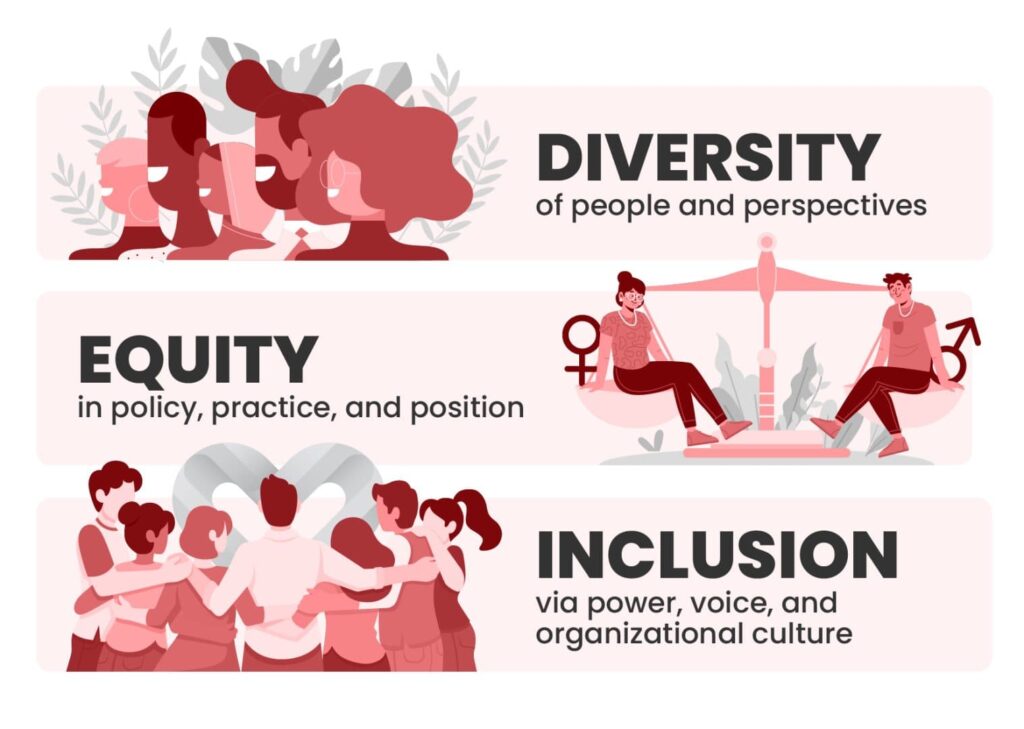In today’s interconnected world, cultural diversity is a crucial component of any successful business strategy, especially for multinational companies engaged in global hiring. Navigating cultural differences and fostering an inclusive work environment can significantly enhance organizational performance and innovation. This blog will explore the importance of cultural diversity in global hiring, the latest trends in promoting diversity, equity, and inclusion (DEI) in hiring practices, and best practices for creating a cohesive and productive global workforce.
What is Global Hiring? and Its Significance
Global hiring refers to the process of recruiting and employing individuals from different countries and cultural backgrounds. This approach enables companies to tap into a vast pool of talent, bringing diverse perspectives and skills to the organization. Embracing global hiring trends is not just a strategic advantage but also a necessity in a globalized economy.
There are several Benefits of Global Hiring such as:
1. Diverse Perspectives: Employees from different cultural backgrounds contribute unique viewpoints, fostering creativity and innovation.
2. Wider Talent Pool: Access to a global talent pool allows companies to find the best candidates, regardless of geographic location.
3. Market Expansion: A diverse workforce with cultural insights can help companies understand and penetrate new markets more effectively.
4. Enhanced Problem-Solving: Diverse teams bring varied approaches to problem-solving, leading to better decision-making and outcomes.
Why Cultural Diversity Matters in Global Hiring?
Cultural diversity in global hiring is essential for creating an inclusive workplace where all employees feel valued and respected. It goes beyond mere representation, encompassing equity and inclusion to ensure that all employees have equal opportunities to succeed.
Highlighting some of Key Elements of Cultural Diversity here…
1. Representation: Ensuring a diverse workforce that reflects different cultures, ethnicities, and backgrounds.
2. Equity: Providing fair treatment, opportunities, and resources for all employees, considering their unique needs and challenges.
3. Inclusion: Creating an environment where all employees feel welcomed, respected, and empowered to contribute fully.

Source: DEI Trends
Current Global Hiring Trends in Diversity, Equity & Inclusion (DEI)
The latest global hiring trends highlight the increasing focus on DEI in recruitment and workplace practices. Companies are adopting innovative strategies to promote diversity and create inclusive environments.
1. DEI-Centric Recruitment Strategies
Organizations are prioritizing DEI in their recruitment processes to attract a diverse talent pool. This includes:
- Bias-Free Job Descriptions: Using inclusive language and avoiding gender-specific terms in job postings.
- Diverse Hiring Panels: Ensuring that recruitment teams represent a mix of cultures and backgrounds to minimize biases.
- Blind Recruitment: Removing personal information from resumes to focus on skills and qualifications, reducing unconscious bias.
2. Employee Resource Groups (ERGs)
ERGs are voluntary, employee-led groups that foster a sense of community and support for employees from diverse backgrounds. They play a significant role in promoting inclusion and providing a platform for employees to share their experiences and insights.
3. Inclusive Onboarding Programs
Inclusive onboarding programs are designed to help new hires from diverse backgrounds integrate seamlessly into the company culture.
These programs may include:
- Cultural Sensitivity Training: Educating employees about different cultures and promoting mutual respect.
- Mentorship Programs: Pairing new hires with mentors who can guide them through their initial period at the company.
4. Flexible Work Arrangements
Flexible work arrangements, such as remote work and flexible hours, accommodate employees from different time zones and cultural backgrounds. This approach not only supports work-life balance but also fosters a more inclusive work environment.

Navigating Cultural Diversity in Global Talent Acquisition
Navigating cultural diversity in global hiring requires a thoughtful and strategic approach. Here are some best practices to help multinational companies manage cultural differences effectively:
1. Conduct Cultural Competency Training
Cultural competency training is essential for helping employees understand and appreciate cultural differences. This training should cover topics such as:
- Cultural Awareness: Understanding different cultural norms, values, and communication styles.
- Inclusive Communication: Promoting respectful and inclusive communication practices.
- Conflict Resolution: Equipping employees with the skills to navigate and resolve cultural conflicts.
2. Establish Clear DEI Policies
Clear and comprehensive DEI policies set the foundation for a diverse and inclusive workplace. These policies should outline the company’s commitment to diversity, equity, and inclusion, and provide guidelines for implementing DEI practices across all levels of the organization.
3. Ensure Compliance with International Labor Laws
Compliance with international labor laws is crucial for managing a global workforce. Companies must stay informed about the labor regulations in each country where they operate and ensure that their hiring practices adhere to these laws. This includes understanding visa requirements, employment contracts, and workplace safety standards.
4. Leverage Technology for Global Hiring
Technology plays a pivotal role in managing a diverse workforce and facilitating global hiring. Key technologies include:
- Applicant Tracking Systems (ATS): Streamlining the recruitment process and ensuring a consistent candidate experience.
- Video Interviewing Platforms: Conducting interviews with candidates from different locations, reducing travel costs and logistical challenges.
- HR Management Software: Managing employee data, tracking DEI metrics, and ensuring compliance with labor laws.
5. Foster an Inclusive Workplace Culture
Creating an inclusive workplace culture goes beyond recruitment and onboarding. It involves fostering an environment where all employees feel valued and included. Strategies to promote inclusivity include:
- Regular DEI Training: Continuously educating employees about diversity, equity, and inclusion.
- Open Communication Channels: Encouraging open and honest communication, and providing platforms for employees to voice their concerns and suggestions.
- Recognition and Celebration: Recognizing and celebrating cultural events and achievements, and highlighting the contributions of diverse employees.
Technology and Its Role in Diversity Management
Technology is a powerful enabler of diversity and inclusion in global hiring. It helps companies streamline their recruitment processes, manage employee data, and foster a connected and inclusive work environment.
1. AI-Powered Recruitment Tools
AI-powered recruitment tools can enhance the efficiency and effectiveness of the hiring process. These tools can:
- Analyze Job Applications: Quickly screen resumes and identify the best candidates based on predefined criteria.
- Reduce Bias: Implement algorithms that minimize unconscious bias in the recruitment process.
- Predict Candidate Success: Use predictive analytics to assess the likelihood of a candidate’s success in a specific role.
2. Virtual Collaboration Tools
Virtual collaboration tools, such as Slack, Microsoft Teams, and Zoom, enable employees from different locations to work together seamlessly. These tools facilitate communication, collaboration, and knowledge sharing, fostering a sense of connection and inclusivity among global teams.
3. Learning Management Systems (LMS)
LMS platforms provide employees with access to training and development resources, regardless of their location. These systems can offer cultural competency training, DEI courses, and other learning opportunities that support an inclusive workplace culture.
Measuring the Effectiveness of DEI Initiatives
Measuring the effectiveness of DEI initiatives is essential for ensuring that your efforts are yielding the desired results. Key metrics to track include:
1. Diversity Metrics
- Representation: The proportion of employees from different cultural backgrounds at various levels of the organization.
- Retention Rates: The retention rates of diverse employees compared to the overall workforce.
- Promotion Rates: The promotion rates of diverse employees within the company.
2. Inclusion Metrics
- Employee Engagement: The level of engagement and satisfaction among diverse employees, as measured through surveys and feedback.
- Participation in ERGs: The participation rates in employee resource groups and other DEI-related activities.
- Feedback and Suggestions: The number and nature of feedback and suggestions received from employees regarding DEI initiatives.
3. Impact Metrics
- Business Performance: The impact of DEI initiatives on overall business performance, including productivity, innovation, and customer satisfaction.
- Talent Attraction: The effectiveness of DEI initiatives in attracting top talent from diverse backgrounds.
Conclusion
In conclusion, navigating cultural diversity in global hiring is essential for building a cohesive and productive workforce in today’s globalized economy. By embracing global hiring trends and implementing best practices, multinational companies can create inclusive environments that attract and retain top talent. This involves prioritizing DEI in recruitment, conducting cultural competency training, ensuring compliance with international labor laws, leveraging technology, and continuously measuring the effectiveness of DEI initiatives.
At JobsPikr, we provide innovative solutions to help you navigate the complexities of global hiring and build a diverse and inclusive workforce. Contact us today to learn more about how we can support your global hiring efforts and help you stay ahead in the competitive job market.
Sign Up today and take the first step towards transforming your recruitment process.



